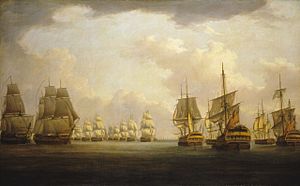HMS Ajax (1798) facts for kids

Watercolour of HMS Ajax, in the collections of the National Maritime Museum; no artist or date given
|
|
Quick facts for kids History |
|
|---|---|
| Name | HMS Ajax |
| Ordered | 30 April 1795 |
| Builder | Randall, Rotherhithe |
| Laid down | September 1795 |
| Launched | 3 March 1798 |
| Commissioned | June 1798 |
| Honours and awards |
|
| Fate | Accidentally burnt, 14 February 1807 |
| General characteristics | |
| Class and type | Ajax-class ship of the line |
| Tons burthen | 1,94346⁄94 (bm) |
| Length |
|
| Beam | 49 ft 6 in (15.1 m) |
| Depth of hold | 21 ft 3 in (6.5 m) |
| Propulsion | Sails |
| Sail plan | Full-rigged ship |
| Armament |
|
HMS Ajax was a powerful British warship. She was a "ship of the line," meaning she was big enough to fight in the main battle line. She had 74 guns! Built in 1798, Ajax served the Royal Navy during important times. She fought in the Egyptian campaign, the Battle of Cape Finisterre, and the famous Battle of Trafalgar. Sadly, a fire destroyed her in 1807.
Contents
The Story of HMS Ajax
Ajax was a third-rate ship of the line. This meant she was a large warship with 74 guns. She was built by John Randall & Co. in Rotherhithe, England. Her launch happened on the River Thames on March 3, 1798.
Early Service and Captains
Ajax was officially ready for duty in June 1798. Her first captain was John Holloway. A month later, Captain John Pakenham took command. He led the ship for service in the English Channel. In May 1799, Captain Alexander Cochrane became her commander. He stayed with Ajax for two years.
On January 9, 1800, Ajax captured a French privateer ship. This ship was called Avantageux. This happened while Ajax was patrolling the Channel.
Fighting in Egypt
In 1801, Captain Cochrane and Ajax joined a big operation in Egypt. On January 31, Ajax anchored at Marmorice. This was on the coast of Karamania.
On March 1, about 70 warships gathered in Abu Qir Bay. They also had transport ships carrying 16,000 soldiers. Bad weather delayed the landing for a week. But on March 8, Captain Cochrane led 320 boats ashore. These boats carried the soldiers to land. French shore batteries tried to stop them. However, the British troops pushed them back. By the next day, the entire force was ashore. Ajax lost two sailors during these landings.
The navy also provided 1,000 sailors to fight on land. Sir Sidney Smith led these sailors. On March 13, Ajax had one man killed and two wounded in a land battle. On March 21, she lost two more men killed and two wounded.
After the Battle of Alexandria, Ajax was among the first ships to enter the harbor. She was with HMS Bonne Citoyenne, HMS Cynthia, and other smaller ships. Because Ajax served in Egypt, her crew later received a special medal. It was called the "Egypt" clasp for the Naval General Service Medal. Ajax returned to England in June 1802.
The Year 1805: Two Big Battles
In April 1805, Ajax was sent to reinforce a British squadron. This squadron was off Ferrol, Spain. Admiral Lord Gardner sent her along with two other ships.
The Battle of Cape Finisterre
On May 31, 1805, Captain William Brown took command of Ajax. On July 22, a British fleet met a combined French and Spanish fleet. This happened off Cape Finisterre. The British fleet had 15 ships. The enemy had 20 ships.

The battle lasted over four hours. Thick fog and fading light made it hard to see. Neither side won a clear victory. But the British captured two Spanish ships. These were the 80-gun San Rafael and the 74-gun Firme. Ajax lost two men killed and 16 wounded in this fight.
The Famous Battle of Trafalgar
After repairs, Ajax sailed to Cadiz, Spain. She joined Vice-Admiral Horatio Nelson's fleet. Captain Brown was called away to be a witness in a court case. So, First Lieutenant John Pilfold commanded Ajax at the Battle of Trafalgar.
On October 21, 1805, Ajax was seventh in Nelson's column. She fired on the French ship Bucentaure and the huge Spanish ship Santissima Trinidad. Ajax also helped HMS Orion force the French ship Intrépide to surrender. During this famous battle, Ajax lost two men killed and nine wounded.
A big storm followed the battle. Ajax helped rescue sailors from other ships. Lieutenant Pilfold was promoted for his bravery. Captain Brown also received the Trafalgar medal. Later, in 1847, all surviving sailors from the battle received the Naval General Service Medal.
After Trafalgar, Ajax was part of the blockade of Cadiz. On November 25, a British ship stopped a Ragusan ship. Ajax shared in the prize money from this captured ship.
The Final Voyage and Loss
In January 1806, Captain Henry Blackwood took command of Ajax. On February 1, 1807, Ajax joined Admiral Sir John Duckworth's squadron. They were going to participate in the Dardanelles Operation.
During this operation, a terrible accident happened. On the evening of February 14, 1807, Ajax caught fire. She was anchored off the island of Tenedos. The fire started in the bread-room. This was where food was stored. The fire quickly grew out of control. Officers and crew had to jump into the water to escape. About 380 people were saved. But sadly, 250 people lost their lives. Many of them had fought at Trafalgar. Ajax burned all night. The next morning, she drifted onto Tenedos island and exploded. A court martial later cleared Captain Blackwood of any blame.
Horsham Museum
You can see a model of Ajax at the Shelley Gallery. This gallery is located at Horsham Museum in Horsham, United Kingdom.


